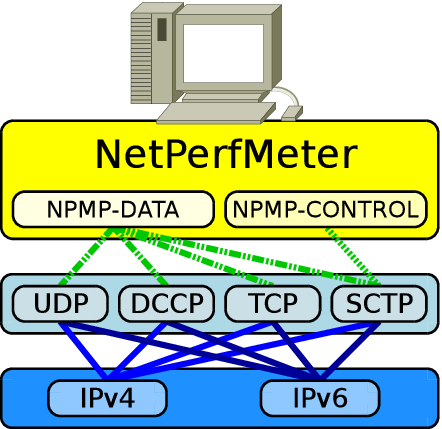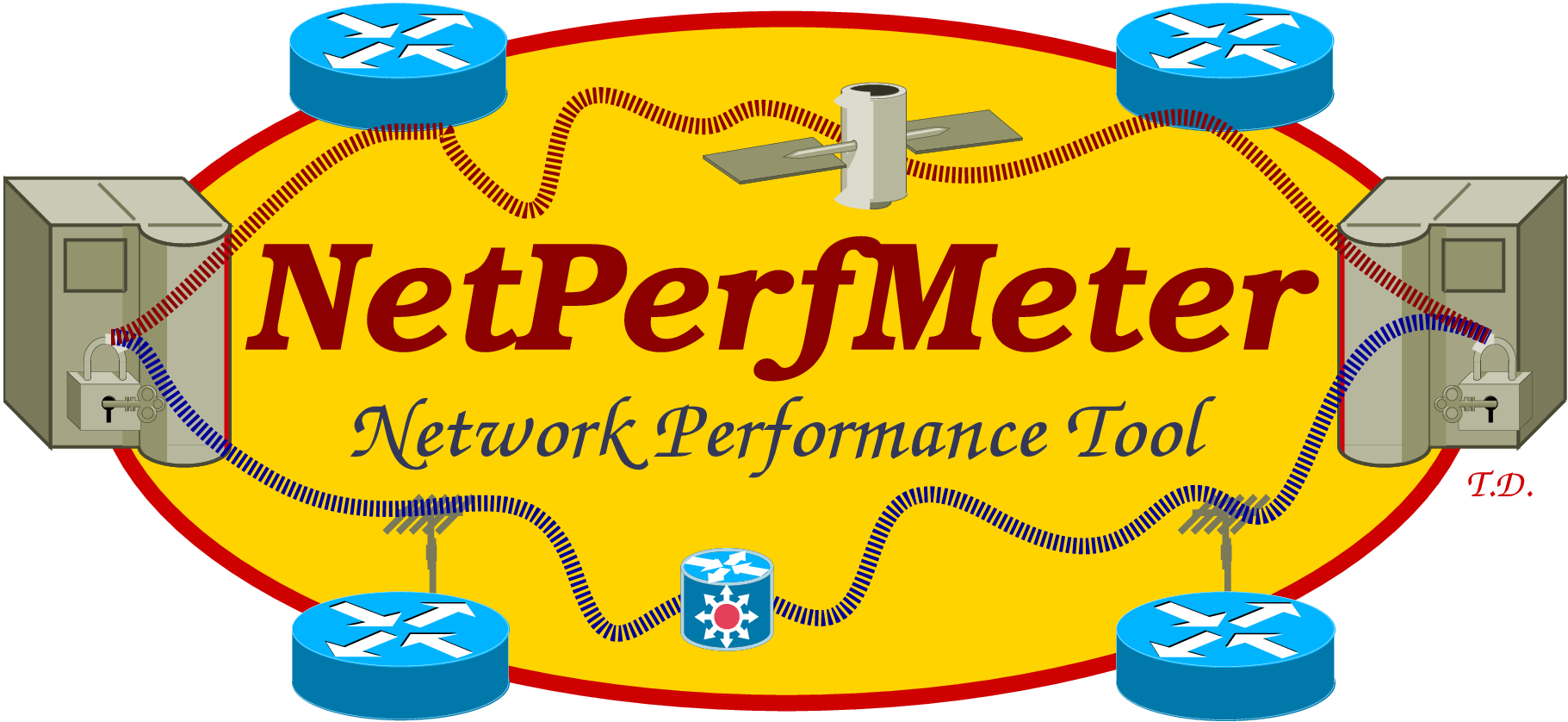New ways to verify that Multipath TCP works through your network
The design of Multipath TCP has been heavily influenced by the middleboxes that have been deployed in a wide range of networks, notably in cellular and enterprise networks. Some of these middleboxes like regular NATs interact correctly with Multipath TCP and many Multipath TCP users work behind NATs. However, some middleboxes, such as firewalls or TCP optimisers, terminate TCP connections or interfere with TCP options and thus interact badly with Multipath TCP.
Several tools can be used to verify that Multipath TCP works through a given network. If you have installed a Multipath TCP enabled kernel, you can simply use curl and issue the following command :
curl http://www.multipath-tcp.org
The webserver that supports http://www.multipath-tcp.org has been configured to send a special response to an HTTP request with the curl User-Agent. If the request is sent over a regular TCP connection, the server replies with :
Nay, Nay, Nay, your have an old computer that does not speak MPTCP. Shame on you!
If the HTTP request is sent over a Multipath TCP connection, the server replies with :
Yay, you are MPTCP-capable! You can now rest in peace.
This is a basic test that if often used to validate the correct installation of a Multipath TCP enabled Linux kernel.
However, many users are interested in simpler tests through a web interface or through a smartphone application. Two young researchers have recently released two useful tools.
http://amiusingmptcp.com has been the first website created to verify that Multipath TCP was working correctly. Unfortunately, it is not anymore up and running. Alexander Frommgen and his colleagues at TU Darmstadt have posted an updated version of this website. In addition to verifying that the web page is served over a Multipath TCP connection, the new web site also checks whether Multipath TCP passes correctly through other ports. You can test it at http://amiusingmptcp.de Other tests will be added soon.
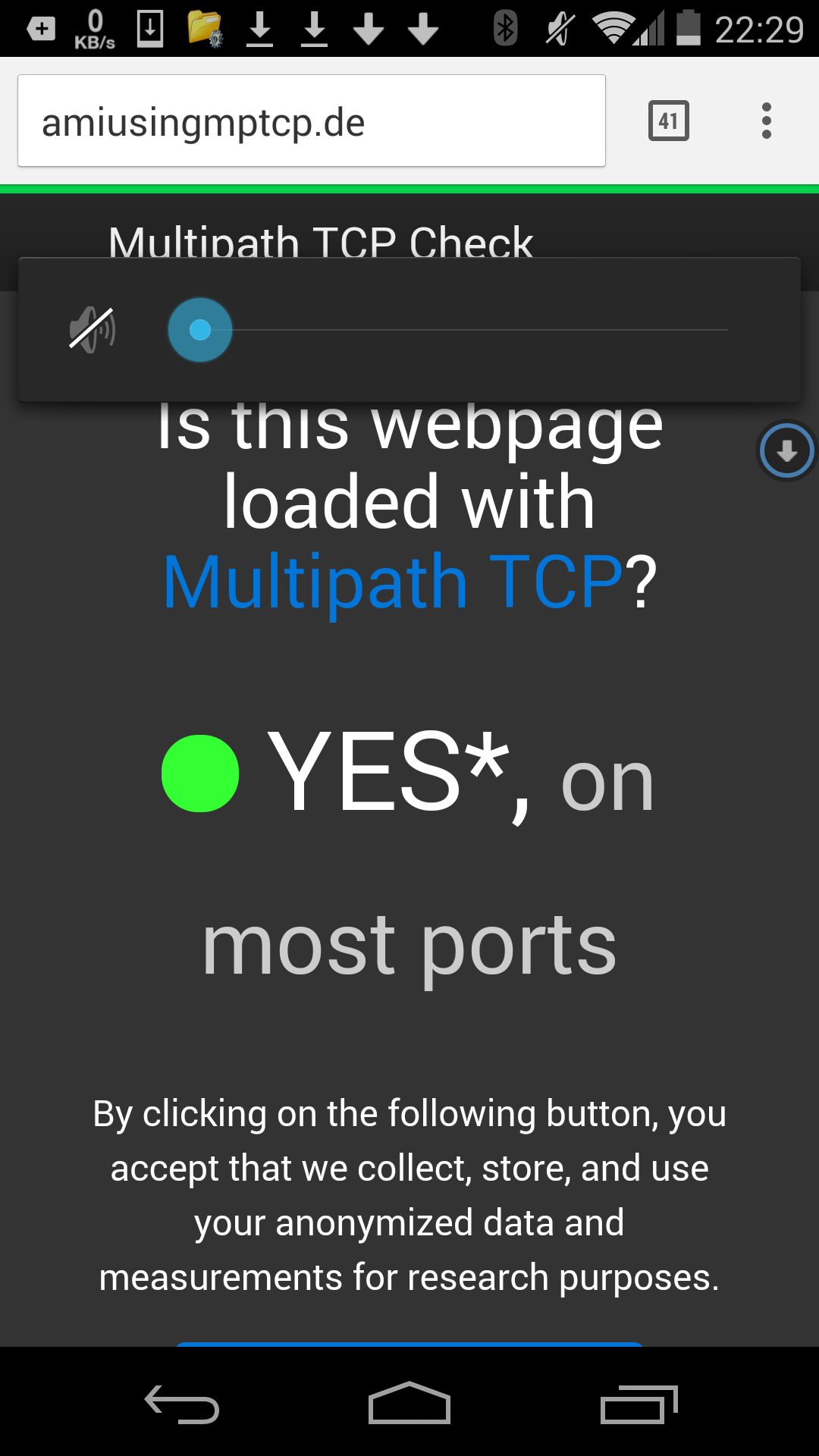
Another option is tracebox. This command-line tool allows to perform traceroute-like tests with different TCP options to verify whether they pass through middleboxes. tracebox works well on Linux and MacOS, but not yet on smartphones.
Raffaele Zullo a student at the University of Napoli in Italy has spent several months at the University of Liege to work with Benoit Donnet. During his internship, he developed a new version of tracebox that runs on Android smartphones. It requires a rooted smartphone, but does not need a Multipath TCP kernel on the smartphone. You can download it from
https://play.google.com/store/apps/details?id=be.ac.ulg.mobiletracebox
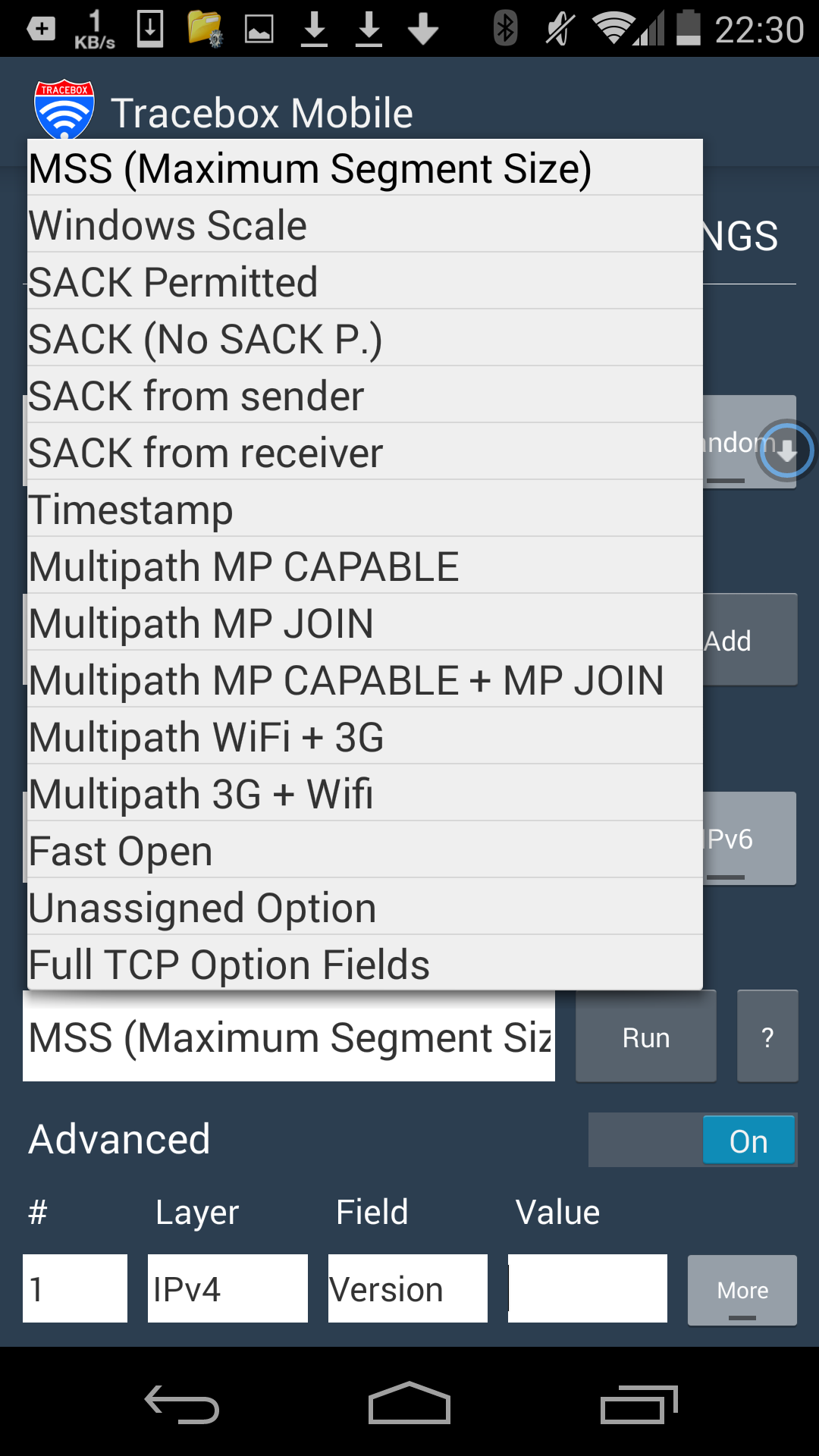
Measuring the adoption of Multipath TCP is not so simple…
In September 2015, a google alert announced a new workshop paper entitled An Early Look at Multipath TCP Deployment in the Wild. The paper abstract was intriguing with sentences like We find that less than 0.1% of Alexa unique domains and IP addresses currently support MPTCP. Their geographic distribution is quite different from that of clients reported in other studies, with the majority of domains being in China. Based on the abstract and the results reported in the paper, one could assume that Multipath TCP has already been deployed on various Internet servers, and the paper lists several important websites in China that are supposed to support Multipath TCP.
Unfortunately, the initial measurements reported in this workshop paper were flawed. Most of the studies on the deployment of TCP extensions have used a network scanner (zmap in this one) to send SYN segments containing a specific TCP option. If the server replies with the same option, then it is assumed to support the TCP extension. The authors of this paper applied the same methodology to Multipath TCP. Unfortunately, looking simply at the presence of an option in the SYN+ACK is not sufficient because there are middleboxes that simply echo any option that they receive. This problem has been discussed in the Multipath TCP mailing list in the past and has influenced the design of Multipath TCP. It is notably described in the article that proposed the tracebox debugging tool.
With tracebox, it is easy to check whether a server really supports Multipath TCP. Let us start with multipath-tcp.org
sudo tracebox -n -v -p "IP/TCP/MPCAPABLE" multipath-tcp.org
tracebox to 130.104.230.45 (multipath-tcp.org): 64 hops max
...
...
...
9: 130.104.230.45 TCP::SrcPort (47416 -> 80) TCP::DstPort (80 -> 47416)
TCP::SeqNumber (554672918 -> 3111441317) TCP::AckNumber (0 -> 554672919)
TCP::DataOffset (8 -> 9) TCP::Flags (( SYN ) -> ( SYN ACK ))
TCP::WindowsSize (5840 -> 28800) TCP::CheckSum (0x5eb9 -> 0x206d)
IP::TotalLength (52 -> 56) IP::Identification (0x50ab -> 0x0)
IP::Flags (0 -> 2) IP::TTL (9 -> 57) IP::CheckSum (0x406 -> 0x1879)
IP::SourceIP (192.168.0.9 -> 130.104.230.45)
IP::DestinationIP (130.104.230.45 -> 192.168.0.9)
+TCPOptionMaxSegSize < TCPOptionMaxSegSize (4 bytes) :: Kind = 2 , Length = 4 , MaxSegSize = 1380 , >
TCPOptionMPTCPCapable::Sender's Key (Sender's Key = 692439777126907904 -> Sender's Key = 17898842517462319104)
The tracebox command is used to send a SYN segment with the MP_CAPABLE option. The output above (only the last line, the interesting one is shown) indicates that the server has replied by adding the MSS option that was not present in the SYN. Furthermore, the SYN+ACK includes the MP_CAPABLE option with a different key than the one sent in the SYN segment.
The same test towards a server that does not (yet ?) support Multipath TCP is shown below :
sudo tracebox -n -v -p "IP/TCP/MPCAPABLE" google.com
tracebox to 109.88.203.231 (google.com): 64 hops max
...
...
...
5: 109.88.203.231 TCP::SrcPort (12002 -> 80) TCP::DstPort (80 -> 12002)
TCP::SeqNumber (304251108 -> 752364946) TCP::AckNumber (0 -> 304251109)
TCP::DataOffset (8 -> 6) TCP::Flags (( SYN ) -> ( SYN ACK ))
TCP::WindowsSize (5840 -> 29200) TCP::CheckSum (0x6797 -> 0xf71)
IP::TotalLength (52 -> 44) IP::Identification (0x7c31 -> 0xaeac)
IP::TTL (5 -> 60) IP::CheckSum (0xbd6 -> 0xd62e)
IP::SourceIP (192.168.0.9 -> 109.88.203.231)
IP::DestinationIP (109.88.203.231 -> 192.168.0.9)
+TCPOptionMaxSegSize < TCPOptionMaxSegSize (4 bytes) :: Kind = 2 , Length = 4 , MaxSegSize = 1460 , >
-TCPOptionMPTCPCapable < TCPOptionMPTCPCapable (12 bytes) :: Kind = 30 , Length = 12 , Subtype = 0 , Version = 0 , Checksum = 1 (Checksum Enabled) , Flags = 0 , Crypto = 1 (HMAC-SHA1) , Sender's Key = Sender's Key = 1674215399152943104 , >
Here, the - (minus) sign before the MP_CAPABLE option indicates that this option was not included in the SYN+ACK. This server clearly does not support Multipath TCP.
Now, let us perform the same test to one server located in China :
sudo tracebox -n -v -p "IP/TCP/MPCAPABLE" cnzz.com
tracebox to 42.156.162.55 (cnzz.com): 64 hops max
...
...
...
23: 42.156.162.55 TCP::SrcPort (7487 -> 80) TCP::DstPort (80 -> 7487)
TCP::SeqNumber (915764810 -> 316943796) TCP::AckNumber (0 -> 915764811)
TCP::Flags (( SYN ) -> ( SYN ACK )) TCP::CheckSum (0x61b5 -> 0x210c)
IP::TTL (23 -> 46) IP::CheckSum (0xaf7c -> 0xcc48) IP::SourceIP
(192.168.0.9 -> 42.156.162.55) IP::DestinationIP
(42.156.162.55 -> 192.168.0.9)
Here, there is no - (minus) sign before the MP_CAPABLE option, which indicates that this option has been echoed by this server. A valid Multipath TCP server would not select the same key as the client, but a middlebox that echoes unknown options would…
Note that this behaviour is not specific to the Multipath TCP option. Any unknown option is echoed by these middleboxes :
sudo tracebox -n -v -p "IP/TCP/TCPOption.new{kind=222, length=4, data={249,137}}" baidu.com
tracebox to 111.13.101.208 (baidu.com): 64 hops max
...
...
...
20: 111.13.101.208 TCP::SrcPort (46253 -> 80) TCP::DstPort (80 -> 46253)
TCP::SeqNumber (569044298 -> 733320366) TCP::AckNumber(0 -> 569044299)
TCP::Flags (( SYN ) -> ( SYN ACK )) TCP::CheckSum (0x57be -> 0x9749)
IP::TTL (20 -> 47) IP::CheckSum (0x9426 -> 0xa4fa)
IP::SourceIP (192.168.0.9 -> 111.13.101.208)
IP::DestinationIP (111.13.101.208 -> 192.168.0.9)
While a normal server removes this unknown option in the SYN+ACK.
sudo tracebox -n -v -p "IP/TCP/TCPOption.new{kind=222, length=4, data={249,137}}" multipath-tcp.org
tracebox to 130.104.230.45 (multipath-tcp.org): 64 hops max
...
...
...
9: 130.104.230.45 TCP::SrcPort (51065 -> 80) TCP::DstPort (80 -> 51065)
TCP::SeqNumber (10489234 -> 3886645051) TCP::AckNumber (0 -> 10489235)
TCP::Flags (( SYN ) -> ( SYN ACK )) TCP::WindowsSize (5840 -> 29200)
TCP::CheckSum (0xb23c -> 0xc02c) IP::Identification (0x2b81 -> 0x0)
IP::Flags (0 -> 2) IP::TTL (9 -> 57) IP::CheckSum (0x3130 -> 0x1885)
IP::SourceIP (192.168.0.9 -> 130.104.230.45)
IP::DestinationIP (130.104.230.45 -> 192.168.0.9)
-TCPOption < TCPOption (4 bytes) :: Kind = 222 , Length = 4 , Payload = \xf9\x89>
+TCPOptionMaxSegSize < TCPOptionMaxSegSize (4 bytes) :: Kind = 2 , Length = 4 , MaxSegSize = 1380 , >
Here, the MSS option has been added and the unknown option has been removed.
After some discussions, the authors of this scan have updated their methodology and now correctly distinguish between real Multipath TCP enabled servers and middleboxes that echo Multipath TCP options. They even provide an interesting dashboard that summarises their measurements at
https://academic-network-security.research.nicta.com.au/mptcp/deployment/

NetPerfMeter : A Network Performance Metering Tool
Introduction
A common problem for evaluating multiple transport protocols in a multi-platform environment is to have a test tool that is capable to run in all these environments, and – of course – to support all necessary protocols. Using different evaluation tools is not a good solution, since each tool may introduce its own – and possibly incompatible – parametrisation scheme. In order to overcome this problem, originally for the use case of evaluating the Stream Control Transmission Protocol (SCTP) and compare it to the Transmission Control Protocol (TCP), NetPerfMeter has been designed and developed.
What is NetPerfMeter?
NetPerfMeter [3][5] is an open source, multi-platform transport protocol performance evaluation software. It currently supports the Linux, FreeBSD and MacOS platforms (with possibility to easily extend it to further platforms), and the transport protocols SCTP, TCP including Multi-Path TCP (MPTCP, if supported by the operating system), UDP (User Datagram Protocol) and DCCP (Datagram Congestion Control Protocol, if supported by the operating system). The figure below presents the NetPerfMeter protocol stack.
In each direction, a data channel can be operated in saturated mode (send as much as possible; not available for UDP-based data channels) or non-saturated mode. In case of the non-saturated mode, the traffic is configured in form of frame rates and frame sizes. That is, frames of a given size are generated in given intervals. Both, frame rate and frame size can be randomised as well.
The performance of the data channels (bandwidth, delay, jitter, etc.) is evaluated and recorded at active and passive side. At the end of a measurement, all collected data is transferred over the control channel to the active side. That is, a user can just conveniently collect all results at the active side. Further details on NerPerfMeter can be found in [3]. [4], [3] also introduce an OMNeT++ simulation model for NetPerfMeter that can be used in simulations, in order to easily compare simulation results and real-world measurements. [1], [2] and [6] provide examples of NetPerfMeter usage for SCTP and MPTCP protocol performance analyses.
Testing MPTCP with NetPerfMeter
In the following, a short tutorial for using NetPerfMeter with MPTCP is provided. It explains the basic features to start experimenting. A more detailed overview of all possible options can be found in the manpage of NetPerfMeter.
Starting the Passive Side
First, the passive side of NetPerfMeter needs to be started:
netperfmeter 9000
This command starts NetPerfMeter in server mode, waiting for control channel connections on port 9000.
Starting the Active Side
One Non-Saturated TCP Flow
Let us start with just one TCP flow:
netperfmeter <passive side>:9000 -tcp const10:const1460:const0:const0
This command starts NetPerfMeter in client mode, connecting to the given peer (given by hostname or IP address), port 9000. A TCP data channel is established, sending 10 frames/s with 1460 bytes/frame from the active to the passive side. The second parameter block specifies 0 frames/s with 0 bytes/frame (that is, no data) in the opposite direction. The measurement ends when stopped by SIGINT (i.e. Ctrl+C).
One Saturated TCP Flow
Making the TCP flow saturated (that is, to send as much as possible) is as easy as setting the frame rate to 0 frames/s (meaning to send as much as possible). Each frame again has a size of 1460 bytes:
netperfmeter <passive side>:9000 -tcp const0:const1460:const0:const0
A Bidirectional TCP Flow
In order to also transmit data in the direction from passive side to active side, just update the parameters:
netperfmeter <passive side>:9000 -tcp const0:const1460:const10:const1460
A fixed frame size of 1460 bytes may not be useful in all scenarios. Therefore, NetPerfMeter provides random distributions as well:
- exp<average>: Negative exponential distribution with given average. Example: exp1000.
- uniform<lower>,<upper>: Uniform distribution from lower to upper bound. Example: uniform500,25000.
Random distributions can of course be used for the frame rate as well.
Multi-Path Transport
NetPerfMeter is also able to turn MPTCP on or off per socket (given that the implementation supports the TCP_MULTIPATH_ENABLE socket option). Then, MPTCP can be enabled by the “cmt=mptcp” option:
netperfmeter <passive side>:9000 -tcp const0:const1460:const0:const0:cmt=mptcp
MPTCP versus TCP
Of course, NetPerfMeter can use multiple data channels as well:
netperfmeter <passive side>:9000 \
-tcp const0:const1460:const0:const0:cmt=mptcp \
-tcp const0:const1460:const0:const0:cmt=off
In this case, NetPerfMeter starts one MPTCP flow and one concurrent TCP flow. “cmt=off” turns MPTCP off (the default; just not specifying the “cmt” option has the same effect).
Recording Statistics
One of the most important features for researchers is of course to easily get machine-readable results files. Two parameters provide the generation of such files:
- -scalar=<prefix>.<suffix>
- : Generates files named <prefix>-<active|passive>-<flow ID>-<stream ID>.<suffix> with aggregates over the whole measurement. The scalar file format is compatible to OMNeT++ scalar files.
- -vector=<prefix>.<suffix> :
Generates files named <prefix>-<active|passive>-<flow ID>-<stream ID>.<suffix> with per-frame statistics. The vector files are text tables that could for example be processed by GNU R2 or GNU Plot3. For convenience, if the suffix ends with .bz>2, the results file is BZip2-compressed on the fly. To automate measurements, the -runtime=<seconds> option specifies a duration of the measurement. That is, the following example would run a 60s MPTCP versus TCP comparison, and record scalars as well as vectors:
netperfmeter <passive side>:9000 \
-runtime=60 \
-scalar=scalars.sca.bz2 \
-vector=vectors.vec.bz2 \
-tcp const0:const1460:const0:const0:cmt=mptcp \
-tcp const0:const1460:const0:const0:cmt=off
Conclusion
NetPerfMeter is a convenient and flexible open source tool for transport protocol performance analysis. It particularly provides multi-platform support and works with TCP, SCTP, UDP as well as DCCP.
References
[1] Dreibholz, T.; Zhou, X. and Fa, F.: “Multi-Path TCP in Real-World Setups – An Evaluation in the NorNet Core Testbed”, in 5th International Workshop on Protocols and Applications with Multi-Homing Support (PAMS), pp. 617–622, Gwangju/South Korea, March 2015.
[2] Dreibholz, T.; Adhari, H.; Becke, M. and Rathgeb, E. P.: “Simulation and Experimental Evaluation of Multipath Congestion Control Strategies”, in Proceedings of the 2nd International Workshop on Protocols and Applications with Multi-Homing Support (PAMS), Fukuoka/Japan, March 2012.
[3] Dreibholz, T.: “Evaluation and Optimisation of Multi-Path Transport using the Stream Control Transmission Protocol”, Habilitation Treatise, University of Duisburg-Essen, Faculty of Economics, Institute for Computer Science and Business Information Systems, March 2012.
[4] Dreibholz, T.; Adhari, H.; Becke, M. and Rathgeb, E. P.: “NetPerfMeter – A Versatile Tool for Multi-Protocol Network Performance Evaluations”, OMNeT++ Code Contribution, University of Duisburg-Essen, Institute for Experimental Mathematics, February 2012.
[5] Dreibholz, T.; Becke, M.; Adhari, H. and Rathgeb, E. P.: “Evaluation of A New Multipath Congestion Control Scheme using the NetPerfMeter Tool-Chain”, inProceedings of the 19th IEEE International Conference on Software, Telecommunications and Computer Networks (SoftCOM), pp. 1–6, Hvar/Croatia, September 2011.
[6] Adhari, H.; Dreibholz, T.; Becke, M.; Rathgeb, E. P. and Tüxen, M.: “Evaluation of Concurrent Multipath Transfer over Dissimilar Paths”, in Proceedings of the 1st International Workshop on Protocols and Applications with Multi-Homing Support (PAMS), pp. 708–714, Singapore, March 2011.
In Korean, Multipath TCP is pronounced GIGA Path
In September 2013, Apple surprised the networking community by enabling Multipath TCP on all iOS devices . The main motivation for this deployment was to support Apple’s voice recognition application and enable it to work seamlessly over both WiFi and cellular networks. Multipath TCP is a good match for this application, but it can also be used for other use cases.
At IETF’93 in Prague, SungHoon Seo provided several very interesting details of the Gigapath commercial service that is now sold by KT. This service enables smartphone users to reach bandwidth of up to 1 Gbps on existing smartphones. This is probably the fastest commercially deployed mobile network. They achieve this high bandwidth by combining both fast LTE (with carrier aggregation) and fast WiFi networks on Multipath TCP enabled smartphones. At this stage, only the Samsung Galaxy S6 and Galaxy S6 Edge smartphones support the Gigapath service, but KT is working with other vendors to add Multipath TCP on their smartphones. Measurements presented at the MPTCP Working Group meeting revealed that current smartphones are able to reach throughputs of about 800 Mbps out of a theoretical maximum of 1.17 Gbps.
What is more impressive is how the system has been implemented and how the users can benefit from it. The figure below, extracted from SungHoon Seo’s presentation provides the general architecture of the GIGA Path system.
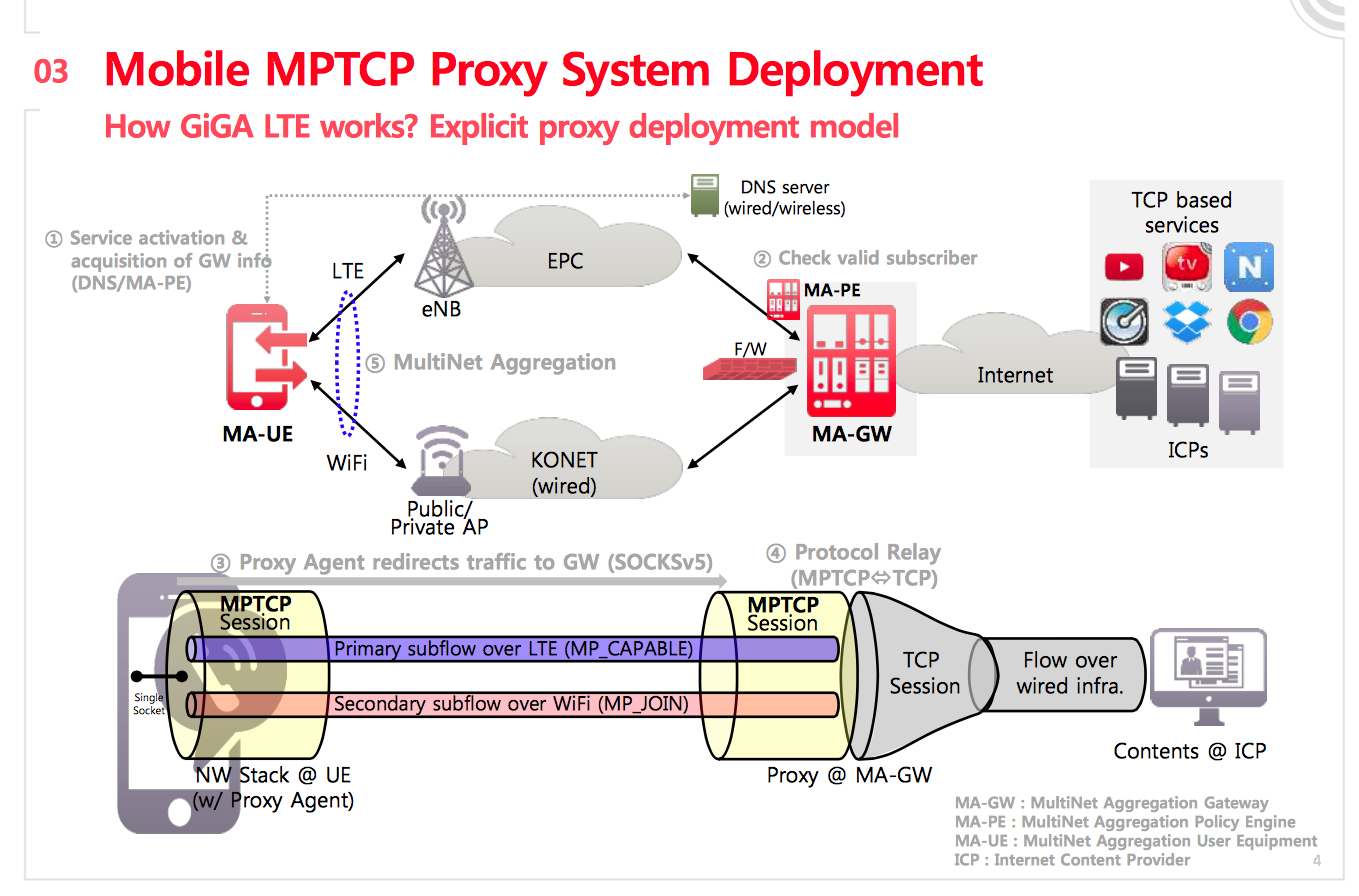
On the client side, the smartphones include the open-source Multipath TCP implementation in the Linux kernel. Samsung reused release 0.89.4 and backported it in their Android kernel. The full source code of their Multipath TCP kernel is available online
Enabling Multipath TCP on the smartphone is the first step in deploying it. However, this is not sufficient since there are very few servers that support Multipath TCP today. To enable their users to benefit from Multipath TCP for all the applications that they use, KT has opted for a SOCKSv5 proxy. This proxy is running on x86 servers using release 0.89.5 of the open-source Multipath TCP implementation in the Linux kernel. During the presentation, SungHoon Seo mentioned that despite the recent rollout of the service, there were already 5,500 active users on the SOCKS proxy the last time he checked. Thanks to this proxy, the subscribes of the Giga Path service in Korea can benefit from Multipath TCP with all the TCP-based applications that they use.
At the end of KT’s presentation, another network engineer mentioned that he would come back to his management and propose a similar approach to deploy Multipath TCP in his network. We can thus expect other large scale deployments in the coming months.
